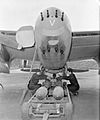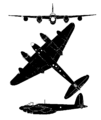De Havilland Mosquito facts for kids
Quick facts for kids DH.98 Mosquito |
|
|---|---|
 |
|
| Mosquito B Mk IV serial DK338 before delivery to 105 Squadron. This aircraft was used on several of 105 Squadron's low-altitude daylight bombing operations during 1943. | |
| Role |
|
| National origin | United Kingdom |
| Manufacturer | de Havilland Aircraft Company |
| First flight | 25 November 1940 |
| Introduction | 15 November 1941 |
| Retired | 1963 |
| Status | Retired |
| Primary users | Royal Air Force |
| Produced | 1940–1950 |
| Number built | 7,781 |
| Unit cost | £9,100 (1951) |
The De Havilland Mosquito was a famous British aircraft from World War II. It was a very successful design. People often called it the "Wooden Wonder" because it was mostly built from wood. This made it lighter and faster than many other planes.
The Mosquito was first planned to be a bomber. But it turned out to be incredibly fast. It could also fly for a long time and carry heavy loads. Because of this, it was used for many different jobs. It became a fighter, a night fighter, an attack plane, and even a photo-reconnaissance aircraft. It was truly one of the most versatile planes of the war.
Contents
The "Wooden Wonder"
The Mosquito was unique because it was made mostly of wood. This included plywood and balsa wood. Building planes from wood was unusual at the time. Most warplanes were made of metal.
Why Wood?
Using wood had several advantages. It was lighter than metal, which helped the Mosquito fly faster. Wood was also easier to get during wartime. Metal was needed for many other things. Plus, wood was simpler to work with for many skilled workers. This meant the planes could be built quickly.
Fast and Versatile
The Mosquito was one of the fastest planes of its time. Its speed was a major defense. It could often outrun enemy fighters. This meant it didn't always need heavy guns for protection.
Many Roles in the War
The Mosquito was used for many important tasks:
- Bomber: It could carry bombs and fly long distances. It was often used for quick, precise bombing raids.
- Fighter: Some versions were armed with cannons and machine guns. They fought enemy planes.
- Night Fighter: With special radar equipment, it hunted enemy bombers at night.
- Reconnaissance: It flew over enemy territory to take photos. These photos helped plan future missions.
- Pathfinder: Mosquitoes would fly ahead of bomber groups. They would mark targets with flares. This helped other bombers hit their targets accurately.
Key Features
The Mosquito had two powerful Rolls-Royce Merlin engines. These engines gave it amazing speed. The plane also had a sleek, aerodynamic design. This helped it cut through the air easily.
Crew and Equipment
A Mosquito usually had a crew of two. This included a pilot and a navigator/bomb aimer. Depending on its role, it carried different equipment. Bombers carried bombs. Fighters had guns. Reconnaissance planes had cameras. Night fighters had radar.
Impact and Legacy
The De Havilland Mosquito played a huge role in World War II. Its speed and versatility made it very effective. It was used by the Royal Air Force and other Allied air forces.
After the War
After the war ended in 1945, the Mosquito continued to serve. Some versions were used for training. Others were used for photography or research. The last Mosquito planes were retired in the 1960s. Today, a few Mosquitos are preserved in museums. They remind us of this incredible "Wooden Wonder."
Images for kids
-
W4050 being restored at the de Havilland Aircraft Heritage Centre near St Albans
-
A preserved Mosquito at the U.S. Air Force Museum (former TT Mk 35 which was restored to B Mk XVI configuration). Note the air and oil coolant radiators in the leading edge of the wing, intake for the two-stage Merlin's intercooler radiator behind the propeller blade, and the carburettor intake with ice guard behind and below.
-
American F-8 Mosquito nose; USAAF markings, PRU Blue finish at the National Museum of the United States Air Force.
-
Bombing of the Gestapo headquarters in the Shellhus, Copenhagen, Denmark, in March 1945. A Mosquito pulling away from its bombing run is visible on the extreme left, centre.
-
A de Havilland Mosquito of the RAF Banff Strike Wing attacking a convoy evacuating German troops in the Kattegat on 5 April 1945. A flak ship and a trawler were sunk.
-
Mosquito B Mk IV Series 2, DK338, built in September 1942 and delivered to 105 Squadron, becoming GB-O.
-
NF Mk XIII of 256 Squadron, with the "bull nose", caught in the beam of a Chance light on the main runway at Foggia, Italy, before taking off on a night intruder sortie.
-
Mosquito FB Mk XVIII NT225 of 248 Squadron Special Detachment. Note the 57 mm Molins gun and streamlined blister used to accommodate the automatic loading mechanism.
-
B Mk IV DK336 of 105 Squadron being prepared for Operation Oyster, December 1942. This aircraft crashed near Shipham while returning from Cologne on 27 January 1943
See also
 In Spanish: De Havilland DH.98 Mosquito para niños
In Spanish: De Havilland DH.98 Mosquito para niños



























